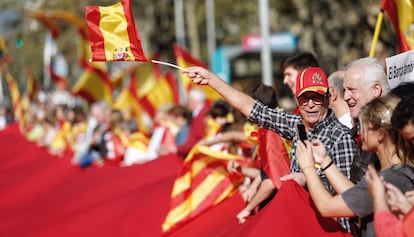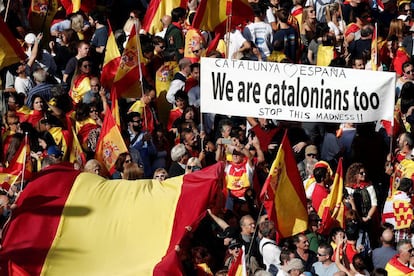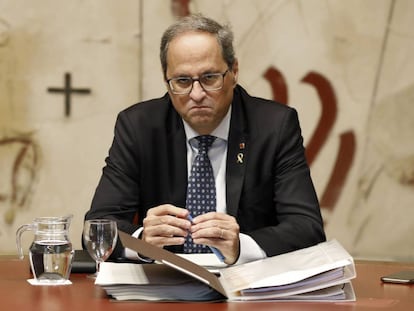Tens of thousands attend march against Catalan independence
Around 80,000 people protested in Barcelona this weekend against the recent street violence in the city that erupted following the Supreme Court ruling, which sentenced nine separatist leaders to prison


Tens of thousands of people marched in Barcelona on Sunday to demonstrate against the Catalan separatist movement, and the disturbances caused by pro-independence protesters following a Supreme Court ruling that sentenced nine separatist leaders to prison.
The situation in Catalonia is shaping up to be a key issue ahead of the general election
According to the municipal police force in the city, around 80,000 people took part in the march, while organizers put the figure as high as 400,000. The protest was called by a civic group called Societat Civil Catalana (SCC) under the slogan: “For understanding, for Catalonia: Enough!” in reference to the street unrest that was seen in Barcelona after the Supreme Court found the separatist leaders guilty of sedition on October 14.
To protest the ruling, pro-independence groups held week-long demonstrations that, while peaceful during the day, descended into violence at night, with protesters clashing with police, torching cars and setting up barricades. According to Barcelona City Hall, the unrest caused €2.7 million in damage.

During Sunday’s march, the president of the SCC, Fernando Sánchez Costa, read out a declaration that stated: “We will never accept or tolerate violence, neither symbolic violence, much less real violence. The streets are and will be for everyone, not for those who use intimidation to take them.”
In his speech, Sánchez Costa called for the resignation of Catalan premier Quim Torra, who has been criticized for his response to the violent protests. “Torra, if you do not know how to govern, if you are not going to govern for all Catalans [not just those who support independence], if you prefer to be an activist, it’s very simple: let’s go to the polls,” he said.
We will never accept or tolerate violence
SCC president Fernando Sánchez Costa
Meanwhile, during the march, one protester argued: “They are trying to make something that is not normal seem normal,” while others chanted: “Here the press don’t have to wear helmets,” in reference to the violent pro-independence protests. Other protesters held signs with more conciliatory messages such as: “I can’t choose between Mom and Dad, nor can I between Catalonia and Spain.”
Sunday’s march against the Catalan independence movement was attended by the leader of the conservative Popular Party (PP), Pablo Casado; the head of the center-right party Ciudadanos (Citizens), Albert Rivera; and two ministers from the caretaker government of the Socialist Party (PSOE), Josep Borrell and José Luis Ábalos. While they had not been invited, the far-right party Vox also took part in Sunday’s demonstration.
The situation in Catalonia is shaping up to be a key issue ahead of the general election on November 10. The PP and Ciudadanos are looking to boost voter support by attacking Spain’s caretaker Prime Minister Pedro Sánchez for his handling of the crisis, and positioning themselves as the defenders of Spanish unity. Government sources confess that every sign of disturbance in Catalonia is a mark against Sánchez.
Pro-independence march
The march on Sunday came a day after hundreds of thousands of pro-independence supporters held a largely peaceful protest in Barcelona. According to the municipal police, 350,000 people came out to join the protest – which is the lowest turnout for a pro-independence rally in the last eight years.
After the daytime march, many of the protesters headed toward the headquarters of the National Police for a demonstration organized by the pro-independence protest group, the Committees to Defend the Republic (CDR). There were more scenes of tension as protesters clashed with riot police, who fired foam bullets at the crowd. Three people were arrested in the protest.
English version by Melissa Kitson.
Tu suscripción se está usando en otro dispositivo
¿Quieres añadir otro usuario a tu suscripción?
Si continúas leyendo en este dispositivo, no se podrá leer en el otro.
FlechaTu suscripción se está usando en otro dispositivo y solo puedes acceder a EL PAÍS desde un dispositivo a la vez.
Si quieres compartir tu cuenta, cambia tu suscripción a la modalidad Premium, así podrás añadir otro usuario. Cada uno accederá con su propia cuenta de email, lo que os permitirá personalizar vuestra experiencia en EL PAÍS.
¿Tienes una suscripción de empresa? Accede aquí para contratar más cuentas.
En el caso de no saber quién está usando tu cuenta, te recomendamos cambiar tu contraseña aquí.
Si decides continuar compartiendo tu cuenta, este mensaje se mostrará en tu dispositivo y en el de la otra persona que está usando tu cuenta de forma indefinida, afectando a tu experiencia de lectura. Puedes consultar aquí los términos y condiciones de la suscripción digital.
More information
Archived In
Últimas noticias
Most viewed
- Sinaloa Cartel war is taking its toll on Los Chapitos
- Oona Chaplin: ‘I told James Cameron that I was living in a treehouse and starting a permaculture project with a friend’
- Reinhard Genzel, Nobel laureate in physics: ‘One-minute videos will never give you the truth’
- Why the price of coffee has skyrocketed: from Brazilian plantations to specialty coffee houses
- Silver prices are going crazy: This is what’s fueling the rally










































